Previous Review
- Analysis, based on Yo Shibuya’s論考 (treatise), of President Donald Trump’s attempt to put Ukrainian territory on the negotiating table.
- The essence of Trump’s proposed “peace plan” is the division of Ukraine’s territory and resources between the US and Russia.
- The Trump camp is an “anti-mainstream imperialist” force opposing globalism (multilateral cooperation), which is the world’s mainstream. There is a structure attempting to revive the pre-war style of re-distribution of territory and resources through interest-based deals, or entente, rather than emphasizing the traditional “alliance” order.
- This carries the concern of a recurrence of a situation similar to the 1939 German-Soviet Non-Aggression Pact—that is, a “redrawing of maps by major powers” excluding the parties involved.
- 1 Prologue: It Began with a Single Message
- 2 1. The Nature of the Trump Administration: "Global Friend of the Far-Right"
- 3 2. Formation of the Post-War System: Origins and Limits of Globalism
- 4 The Trump Administration's Withdrawal from Alliances
- 5 Appendix: Japan and South Korea – Responses to Trump's First Term
Prologue: It Began with a Single Message
Election Interference in an Ally That Shocked the World

The 2024 German general election.
Even before the ballot boxes were opened, an unusual message arrived from America.
“We wish for the victory of the far-right.”
This message 1 was issued by the campaign of President Donald Trump.
In the German general election, the Trump campaign fully supported the far-right party “AfD (Alternative for Germany),” whose executives defend the Nazi regime. The blatant election interference by the campaign of a sitting U.S. president in an allied nation, as if targeting an enemy country, astonished the international community.
Their series of statements were not “slips of the tongue.” They raised the “beacon of international solidarity among the far-right” that transcends national borders. This clearly demonstrated that the U.S. had abandoned its respect for international alliances like NATO and its neutrality in the domestic politics of allied nations.
What exactly is happening in the world?
In this article, inspired by Yo Shibuya’s continuing treatise, we will examine the historical positioning of the Trump administration. Is it appropriate to view the current situation as a simple return to an 帝国主義 (imperialism) 2 era? If so, are we to be a weak presence that, amidst powerful nations dividing the world, can only feebly advocate for “exclusive defense” (専守防衛 – a Japanese defense policy of limiting military action to defensive purposes) and “international cooperation” (国際協調) to “preserve the world as it has been”?
We would be grateful for your comments and impressions after reading.
1. The Nature of the Trump Administration: “Global Friend of the Far-Right”
Deviation from Republican Hawks (Conservatives)
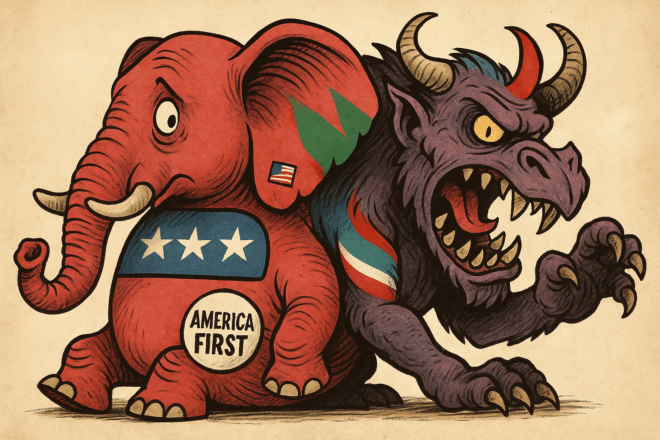
The Trump administration, being a “Republican administration” of America’s two traditional conservative parties, probably had a relatively weak image of European far-right or neo-Nazi parties (especially in its first term). All issues were attributed to Trump’s unusual character, giving him the image of a macho hawk within the party.
However, the current Trump administration has significantly deviated from the image of the former “Republican hawks.” The hawk (conservative) line has been characterized by a “small government” approach, along with national strengthening and a hardline stance on foreign policy. However, the Trump administration has become increasingly characterized by xenophobia, nationalism, and anti-liberalism, transforming it into an entity more akin to European far-right forces rather than traditional conservatives.
Affinity with the European Far-Right
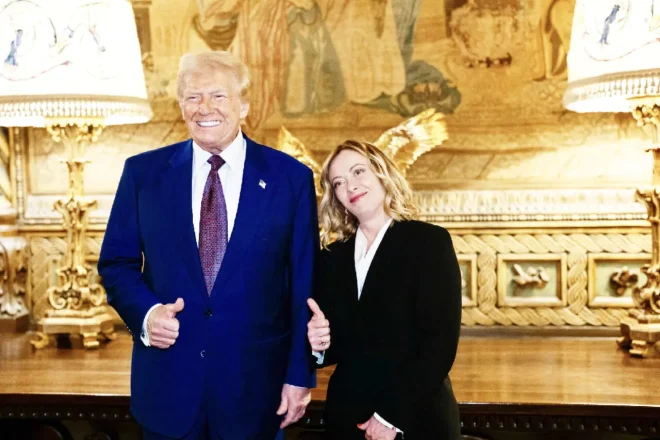
Indeed, prominent far-right leaders from various countries were invited and gathered at Trump’s presidential inauguration. Among European leaders, Italian Prime Minister Giorgia Meloni (Prime Minister of Italy, leader of the Brothers of Italy party, a far-right political party), representing the neo-fascist movement, was the only one invited.
European media reported that the guest list revealed “who Trump might listen to.” (Jiji Press: 2025/01/20)
European far-right figures like Marine Le Pen of France, Viktor Orbán of Hungary, and AfD of Germany, while varying in degree, also advocate for immigrant exclusion, withdrawal from alliances like the EU, cessation of international aid, cooperation with religious conservatives, and “America First” slogans, similar to Trump. They aim to undermine trust in traditional democratic institutions and shift towards a nationalistic system.
Within this group, Italian Prime Minister Meloni is an exception in her stance on “continued” support for Ukraine. However, leaders of the far-right in the European Parliament, such as Hungarian Prime Minister Viktor Orbán (Prime Minister of Hungary, known for his conservative and nationalist policies), are clearly pro-Russia and pro-China, and have refused military aid to Ukraine.
Indeed, the Trump forces are part of this group of xenophobic, “America First” nationalists. And as seen with Mr. Orbán, many forces close to the Kremlin are gathered there.
(Trump’s Shift to US-Russia Imperialist Entente: Yo Shibuya)
International Cooperation with “Authoritarian Leaders”
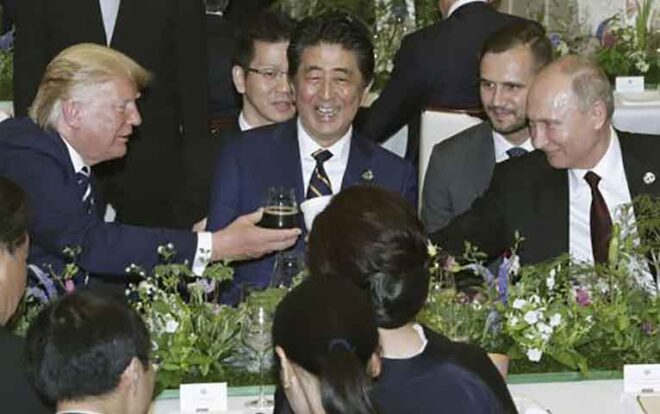
Furthermore, outside of Europe, Trump has emphasized personal relationships with “authoritarian leaders” such as Putin (Russia), Bolsonaro (Brazil), and Netanyahu (Israel).
Overall, this constitutes an international solidarity with latecomer nations (authoritarian states) that demand a share of interests, opposing the rules of status quo maintenance (liberalism, international cooperation) by the established capitalist powers (mainstream imperialism).
Combined with his relations with the European far-right, this now forms a structure that could be called a “far-right global alliance” centered around Trump.
Trump’s favorable stance toward Kim Jong-un of North Korea, and the fact that latecomer emerging economies like China and India did not join sanctions against Russia, thus diminishing the effectiveness of anti-Russia sanctions, may seem unrelated at first glance, but at their core, they are connected to this trend.
Commonality between Putin and Trump (= “America First” / “Russia First”)
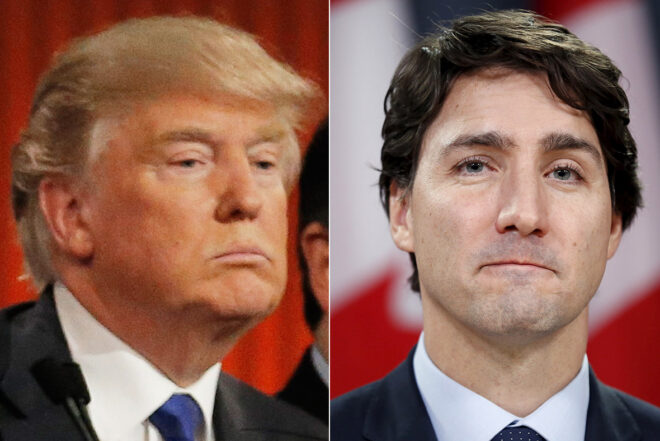
By the way, why are so many in the Trump administration and its allies pro-Russia and pro-Putin? As one answer, Mr. Shibuya points out that Putin and Trump share policy commonalities. I believe this is an important observation. Below are a few excerpts:
“U.S. imperialist Trump is saying things that affirm Ukraine’s ‘territorial cession’ to the Kremlin (omitted). This is integrated with policies Trump has begun to implement, such as making Greenland, a Danish autonomous territory, a U.S. possession for ‘security’ reasons, renaming the Gulf of Mexico ‘American Gulf,’ or the return of the Panama Canal from Panama (omitted).”
“They are successively declaring and practicing the ‘change of sovereignty and territory’ through ‘force (exercise of state power).’ This is the same as the Kremlin’s change of ‘sovereignty and territory’ against Ukraine and others through state violence.”
“Such actions are ‘America First,’ and if I may say so, they demonstrate identity with the Kremlin’s ‘Russia First.’“
“Therefore, Trump fundamentally lacks the value system to analyze what the Kremlin is doing as a destructive act against the order of international law.”
In other words, Trump is not “condoning” actions that disregard the principle of “prohibition of changing the status quo by force (= international cooperation)”; rather, he is fundamentally a member of such forces. This is where Trump’s uniqueness lies.
That is why Trump can recognize Putin, who is similar to him, as a party to a deal and an entente partner, but he cannot have the universal recognition that Putin is an “enemy of peace and human rights.” On the contrary, he even says that such notions (freedom, human rights, equality) are “ridiculous and have ruined the country.”
Whether it’s Russia First, America First (or Japan First), the logical structure is generally the same. It unilaterally states “historical facts” of self-centered nationalism, positions the strong as if they are victims, and uses this as a basis to justify the exercise of powerful state authority to force changes to the status quo upon the weak.
At the root of this thinking is a distrust of the current democratic system and international order. For those who feel “abandoned” under the current mainstream imperialism, giving them easily identifiable “enemies” like foreigners or leftists resonates with their feelings.
Therefore, in the next chapter, we will properly examine how the post-war “alliance = cooperation” system came into being in the first place, and how Trump’s national strategy, which opposes and transforms it amidst the deadlock and stagnation of that post-war system, came to be. We will look at the historical positioning of the Trump administration in post-war history.
2. Formation of the Post-War System: Origins and Limits of Globalism
Starting Point: Drastic Changes in the International Structure After World War II

After the end of World War II, the fascist states of Japan, Germany, and Italy collapsed. The victorious nations, especially Britain and France, were severely exhausted and had lost the vitality to engage in wars and ententes over colonies and markets as they had before.
Amidst this weakening of imperialism, firstly, “workers’ states” (労働者国家 – a term used in Marxist theory to describe a state in which the working class holds political power) appeared “in groups,” whereas previously only the Soviet Union existed. Secondly, national independence movements (民族独立運動 – movements aimed at achieving self-determination and sovereignty for a nation or people, often from colonial rule) surged in Asia, Africa, and Latin America, which had been under colonial rule (the emergence of the Third World). Thirdly, there was a rise in labor movements and revolutionary movements (革命運動 – movements aimed at fundamental and often radical changes in political and social structures) among the populace, who had suffered greatly from the war.
Thus, the world order was largely rewritten. In this situation, only America emerged greatly, having survived the war with its mainland intact and serving as a major export base for food and materials for reconstruction.
In this way, the imperialist nations, which had once competed for hegemony, including Soviet Stalinism as one of their members, became an American unipolar system both economically and militarily.
Transition from “Wars of Partition” to “Institutional Imperialism”
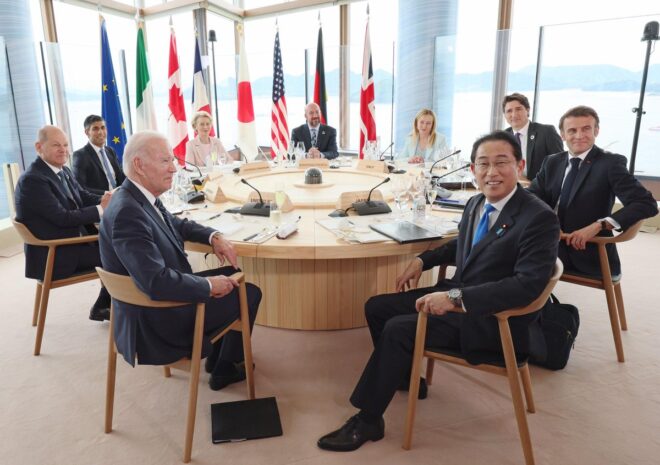
As imperialism as a whole faced a crisis, not just a problem of one country, America, instead of fighting among imperialist powers, rushed to rebuild imperialist nations, providing enormous aid even to defeated nations like Japan and West Germany (former enemies). This “capitalism from above” (上からの資本主義 – a term referring to economic development driven by state intervention and foreign aid rather than grassroots movements) funded by American capital (e.g., Marshall Plan, GARIOA and EROA funds) became a common characteristic of post-war capitalist countries.
The first decisive factor in the post-war world was the transition to “institutional imperialism” through global organizations like the IMF, World Bank, and GATT (later WTO), with America as the leader. Furthermore, it established a system of deploying U.S. forces worldwide through “military alliance” strategies such as NATO, the Japan-U.S. Security Treaty, and the U.S.-ROK Alliance, as a containment measure against the Soviet Union.
As a second factor, imperialism, forced to concede to national independence movements, recognized the political independence of colonies (leading to a rush of new nation-states) and instead shifted to neo-colonialism, centered on economic and social dominance.
As a third factor, centered on a “free trade system,” Keynesian policies were used to create a system that avoided recessions (especially depressions) through “state intervention in the economic process (state monopoly capitalism policies)” not only domestically but also on a global scale. Even at forums like the G7, countries began to comment on each other’s economic policies, and the international cooperation line strongly extended to the economic sphere.
And as a fourth factor, against the backdrop of economic stability and rapid growth brought about by Keynesian policies, “full employment and welfare” policies were developed to neutralize labor movements and left-wing movements and incorporate them into the capitalist system (shifting from revolution to wage increases).
In other words, these developments mean that imperialism, whose scope of activity was narrowed by anti-imperialist movements both domestically and internationally (Cold War structure, labor movements, decolonization struggles), could no longer “divide” the world through “ententes” as it once did. Instead, it transitioned to a system where it maintained mutual order through “rules” and countered anti-imperialist forces through “alliances.”
Decline of America and Decrease in Influence
As it transitioned to institutional imperialism, America reigned at its center. The Bretton Woods system, adopted in 1944, supported the stability of the international economy with a gold-standard dollar fixed exchange rate as the key currency. America, with its overwhelming economic power and gold reserves, led the framework for currency, trade, and development.
However, from the late 1960s, America suffered from enormous fiscal deficits and trade deficits due to the Vietnam War, and could no longer sustain the convertibility of the dollar to gold.

Then, in 1971, President Nixon announced the suspension of dollar-gold convertibility, known as the Nixon Shock, which led to the complete collapse of the Bretton Woods system. This marked a major turning point for the world thereafter.
As other nations’ economies have grown stronger, the time has come for them to bear a fair share of the burden of defending global freedom. It is time for major nations to correct exchange rates and compete on an equal footing. America no longer needs to compete with one hand tied behind its back.
(From President Nixon’s statement: 1971/08/15)
Although America was supposed to have “won” the Cold War with the Soviet Union, it was actually at the same time that Keynesian policies, the greatest driving force behind its Cold War victory, were faltering due to the spread of stagflation (simultaneous recession and inflation).
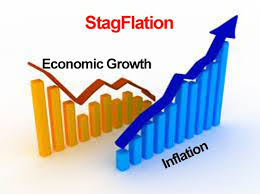
Countries began to introduce consumption taxes (large indirect taxes) as a revenue measure under stagflation and shifted their policies towards neoliberal economics, which forms the basis of current mainstream economics, demanding sacrifices from their citizens (e.g., Reaganomics, Thatcherism, Nakasone administrative reform). After the disappearance of the “socialist bloc” as a rival, this trend became even more pronounced.
Although America maintained its influence as the “world’s policeman” through military power and finance, this became more relative than institutional. Internal weakening, such as the hollowing out of domestic industries, chronic fiscal deficits, and employment insecurity due to globalization, could not be stopped.
As a result, America had already lost the power to unilaterally dominate the world economy.
Nevertheless, no nation emerged to replace America in leading the world order or economy. Countries could not implement fundamental measures other than demanding further sacrifices from their citizens. This fertile ground of mature capitalism and public dissatisfaction eventually became a breeding ground for the far-right and racism.
Retreat from “Sole Hegemony” to “Burden Sharing”
Thus, the managed “institutional imperialism” system centered on America, as the first factor in the post-war world discussed earlier, weakened. The abandonment of Keynesian policies and “welfarism” (deregulation and self-responsibility), as the third and fourth factors, continues to this day.
In recent years, America has found it impossible to unilaterally exercise military power and influence worldwide, following the rise of emerging nations like China and India, fiscal burdens, increasing domestic division, and failures in foreign interventions such as the Iraq War and the withdrawal from Afghanistan.
Nevertheless, maintaining an international order centered on imperialism still requires America to play its role as the core of alliances. As a new direction in this regard, America has gradually begun to pressure its allies to “share the burden,” acting more as a “global coordinator” than a hegemonic power.
The impact is evident in Japan as well. The Japan-U.S. Security Treaty system has become increasingly reciprocal, and the integration of the Self-Defense Forces (SDF) and the U.S. military has been promoted as policy. In response to America’s strategic expectations, Japan has reorganized the SDF to partially assume the role of the U.S. military as the “gendarme of Asia.”
The reorganization of military alliances (SDF) in the Far East symbolized America’s governing structure retreating from “sole hegemony” to “burden-sharing dominance.”
The Trump Administration’s Withdrawal from Alliances
Prior to Trump, U.S. administrations, whether Democratic or Republican, consistently emphasized the post-war “alliance strategy” as America’s global strategy and sought to reorganize and strengthen the framework of the Japan-U.S. Security Treaty.
Bush, Obama, and Biden all promoted the military integration of the SDF and the U.S. military, and sought to address the decline in the U.S. military’s presence in the Far East by forming a “trilateral military alliance of Japan, the U.S., and South Korea,” including South Korea.
On the other hand, the Trump administration’s policy is: “If you want protection, pay for it.” He began to treat alliances as a business, making direct “demands” for U.S. military presence to Japan and South Korea.
There are no ideals or values there; only the blatant logic of imperialistic profit distribution: “How much can you pay?” and “How much will you concede?”
Trump Treats the Japan-U.S.-ROK Alliance as a Deal
For Trump, alliances are not about “mutual trust or institutional cooperation for security” but merely “transactions.” He makes direct “demands” regarding the cost of U.S. military presence to Japan and South Korea.
This is not mere speculation; in a press conference in March, he explicitly stated his perception that the Japan-U.S. alliance is nothing more than a business (deal).
“There’s an interesting deal with Japan. We have to protect Japan, but Japan doesn’t have to protect us. (omitted) Who made such a deal?”
“Trump Dissatisfied with Japan-U.S. Security Treaty” from NHK article, March 7, 2025
This difference also represents a divergence in how to “resolve” the decline of American hegemony. While Biden seeks to maintain order through “institutions and cooperation,” Trump aims to turn it into a “deal (entente).”
There are no ideals or values there; only the blatant logic of “raw, old-fashioned imperialism” in terms of profit distribution: “How much can you pay?” and “How much will you concede?”
Trump Administration’s Military and Foreign Policy

This is clearly demonstrated by what Vice President Vance said at the U.S. Naval Academy graduation ceremony (Reuters article, May 26, 2025).
According to the article, Vice President Vance emphasized that “the era when the United States stood inarguably supreme is over.” He stated that in the future, the U.S. would avoid involvement in endless conflicts, criticizing past interventions like the Iraq War and the Afghanistan invasion as foreign policies that maintained defense and alliances “even if they served little U.S. national interest,” and expressed the view that “no more open-ended missions, no more open-ended conflicts.”
On the other hand, as evidenced by his statement that the U.S. military would maintain its superiority and, presumably with Iraq in mind, “deliver a strong decisive blow when it strikes,” it is clear that the Trump administration is neither interested in disarmament nor has awakened to international peace. It has simply shifted from international cooperation to a ruthless egoism prioritizing profit and loss.
Looking at the historical context, the Trump administration’s military and foreign policy of “withdrawal from alliances” and “shifting from hostility to entente with authoritarian states” is not a return to an era of world domination and war by great powers like during the heyday of imperialism. Rather, it is a manifestation of America’s decline, as it can no longer unilaterally sustain the international order.
How to Position Trump’s “Entente Diplomacy”
Nevertheless, until now, the U.S.-centered alliance system has been used to counter traditional anti-imperialist forces. However, the declaration that “the era when the United States stood inarguably supreme is over” is nothing more than a declaration that the U.S. has “opted out” even from that, and must now focus all its national power inward.
This can be viewed in two ways: one, as a new historical stage where the global capitalist camp (mainstream imperialism), including the U.S., has become so weak; and two, as merely a new policy to adapt to the current situation, similar to the human rights diplomacy of the former Carter administration, implying that it will eventually have to revert to the alliance strategy.
In any case, “America First” and “deal diplomacy” are positioned not as means to restore absolute hegemony, but as a desperate measure to compensate for declining influence.
Challenges for Anti-War and Citizen Movements in the Trump Era
But wait a minute!
For most of the post-war period, if not all, anti-war citizen movements have been a resistance against the LDP government, which has been preoccupied with the integration of the U.S. military and the SDF, and with heightening regional tensions rather than peace, effectively acting as an unrealistic shield for America in the Far East. Or they were international solidarity movements opposing the suppression of national liberation struggles by the U.S. military and CIA in the Third World.
But Trump says he wants to stop that, doesn’t he? Even if he isn’t seeking peace, he says the security treaty is outrageous, denies the Iraq War, and might shake hands with Kim Jong-un tomorrow. In his first term, there were people around him who offered advice and stopped various things, but in his second term, he has surrounded himself with yes-men, forming a dictatorial regime. There’s no telling what he might say or do.
Of course, xenophobic, nationalistic, and far-right domestic policies are unacceptable and not someone else’s problem. Including those, we would like to proceed with the challenges facing us in Japan. However, it has become a bit long, so I will pause here and continue next time.
※This article is the middle part. Next time, based on future predictions, we would like to consider proposals for the attitude we should take.
⇒ Continues in “Trump’s Colonialism with a Face of Peace (Part 2)”
Appendix: Japan and South Korea – Responses to Trump’s First Term
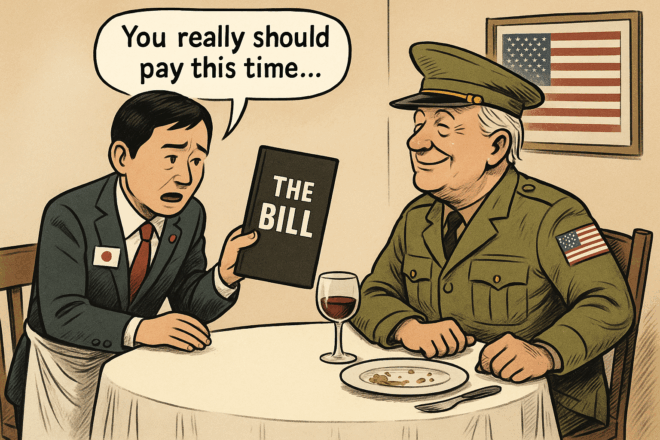
Trump’s “pay up” and “free ride on security” arguments during his first term heavily pressured Japan and South Korea to reorganize the Japan-U.S. and U.S.-ROK alliances. The responses of Japan and South Korea showed distinctly different directions. For reference, I will summarize them as an appendix.
Japan: Active Subordination and Assimilation

The Japanese government, particularly the Abe and Suga administrations, offered almost no overt resistance to Trump’s pressure. Instead, the Abe administration emphasized “trust” with the U.S. while aggressively pushing for the integration of the Self-Defense Forces and the U.S. military.
- Normalization of Japan-U.S. joint exercises
- Hollowing out of “exclusive defense” (検討 – consideration of possessing collective self-defense and enemy base strike capabilities)
- Massive arms purchases (F35, Aegis Ashore, etc.)
- Cooperation in U.S. military realignment (Okinawa, Henoko base construction, etc.)
These policies have continued and accelerated under the Biden administration, leading to the military integration of the “trilateral cooperation” among Japan, the U.S., and South Korea.
In other words, Japan can be said to have met Trump’s demands by “preemptively taking on” the burden reduction for the U.S. military. Alternatively, Abe may have used Trump’s “external pressure” to advance military expansion.
Incidentally, because of this, among the leaders of developed countries, Abe was exceptionally able to “serve” as Trump’s “favorite.”
This course of events is not only seen as “treason” by some on the left, but even by some on the right, and such a “honeymoon” is by no means welcome for us, the citizens.
South Korea: Cautious Response and Emphasis on Autonomy
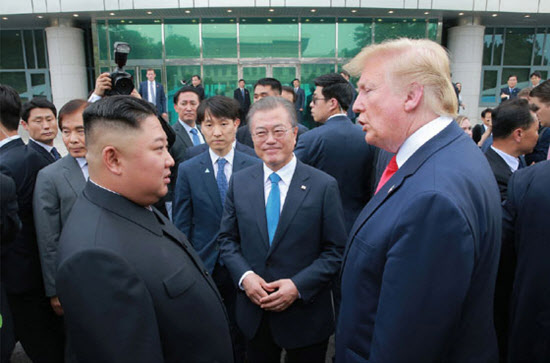
South Korea, like Japan, initially faced pressure to increase defense spending during the Trump administration. However, the Moon Jae-in administration (문재인 정부 – 2017-2022, a progressive government in South Korea) took a different stance from Abe.
- In U.S.-ROK defense cost negotiations, strongly resisted Trump’s demands, leading to repeated breakdowns in negotiations.
- Engaged in independent diplomacy, such as inter-Korean summits, and even involved Trump in them.
- Maintained a certain distance from the U.S.-led Indo-Pacific strategy, seeking to balance it with maintaining relations with China.
- In other words, South Korea sought to maintain diplomatic balance and autonomy rather than “active subordination.”
However, after the conservative Yoon Suk-yeol administration (윤석열 정부 – 2022-2024, a conservative government in South Korea) took office in 2022, South Korea again shifted its policy towards closer ties with the U.S. As a result, under the Biden administration, the trilateral military alliance among Japan, the U.S., and South Korea progressed. Subsequently, in 2024, President Yoon was impeached, and the Yoon Suk-yeol administration collapsed. In the aftermath, the progressive Lee Jae-myung administration (이재명 정부 – 2025-, a progressive government in South Korea) was re-established in 2025.
While future developments remain uncertain, South Korea will likely continue to seek its own unique position, considering its economic ties with China and the North Korean issue.
Japan’s “Loyalty,” South Korea’s “Distance”
This difference is less about diplomatic tactics and more about whether to maintain the “illusion of equality” in relations with the U.S.
- Japan tends to adopt policies that maintain the pretext (illusion) for its citizens that “the Japan-U.S. alliance is an equal relationship sharing common values.”
- South Korea, a divided nation where military matters are more immediate than in Japan, has a stronger realism that views “alliances as a convergence of interests, always requiring adjustment and dialogue,” always leaving room for negotiation.
As a result, Japan’s approach to the “reorganization of American hegemony” is “assimilation” with the U.S. military, while South Korea’s is “adjustment,” leading to different ideas and responses.
Nothing is as Expensive as Free

The “integration” of the Self-Defense Forces with the U.S. military may sound good, but in reality, it means serving as a subcontractor for the U.S. military, or at best, as a vanguard to protect America.
In the past, the Japanese government has consistently intensified domestic propaganda to align with America’s global strategy at the time, citing “threats from the Soviet Union,” “threats from North Korea,” “threats from China,” and so on, all for the purpose of integrating with the U.S. military.
In recent years, propaganda aligning with America’s policy of “having the SDF take over Taiwan’s defense” has been rampant, and Japan has absolutely no room for independent diplomacy.
It is always assumed that Japanese people will be used as a shield to buy time to protect the U.S. military, and questioning or opposing this is labeled as “traitorous.”
In my opinion, Japan has allowed U.S. military bases to be stationed here for free, despite the geopolitical risks, and has even covered their expenses and construction costs with our tax money, thanks to which the U.S. has maintained its hegemony in Asia, the Far East, and the Middle East for many years, haven’t they? I think we are the ones who should be demanding payment.

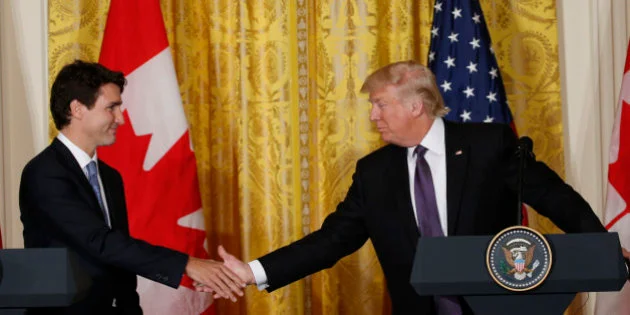




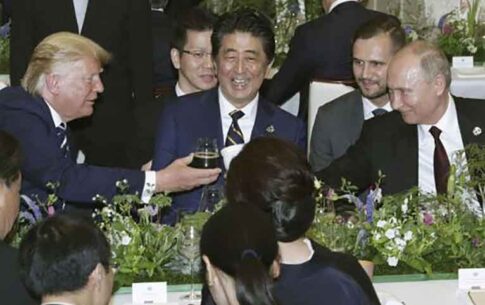
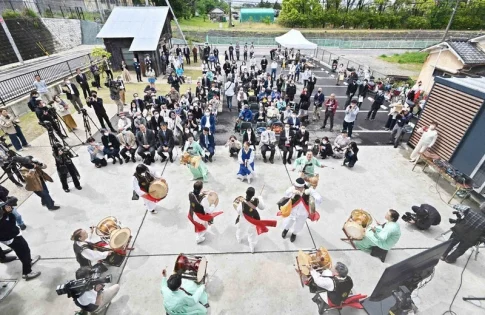



 Donations are made in Japanese yen. 300 yen is approximately 2 USD.
Donations are made in Japanese yen. 300 yen is approximately 2 USD.




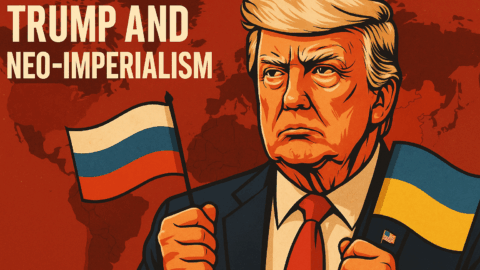

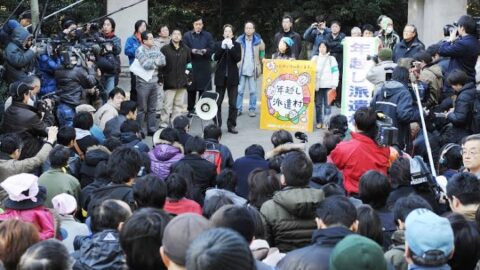
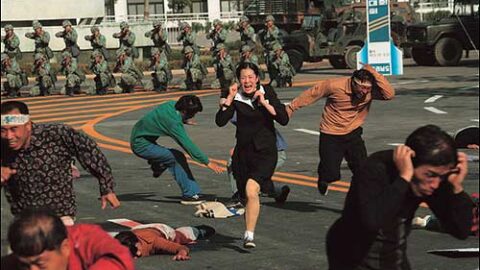


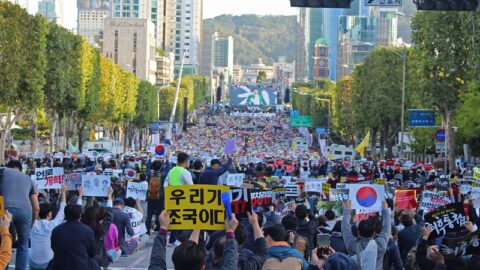
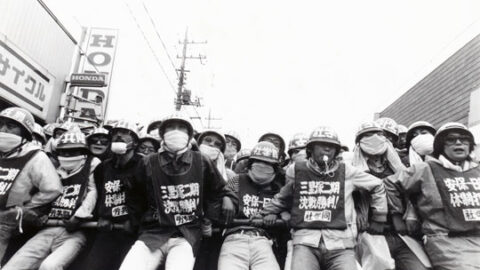





Leave a Reply